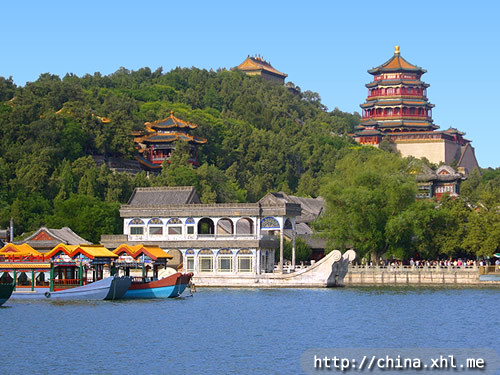The Summer Palace
May 2nd, 2010 No Comments Category: China Destinations Feed for this Entry
The Summer Palace(Chinese: 颐和园) is located on the western edge of Beijing, between the fourth and fifth ring roads, close to the western hills, 12km from central Beijing. It is not expensive to get there by taxi and does not take long. Use a map to tell the driver you want to be taken to the north gate if you would like to follow our suggested route through the park, or ask your hotel receptionist to add 'north gate' to 'Summer Palace' written in chinese script on a piece of paper to show the taxi driver.
The Summer Palace is the largest and best-preserved imperial garden in China. Its chinese name, YiHeYuan, translates as 'Garden of Nurtured Harmony' or 'Garden for Maintaining Health and Harmony'.
As its name implies, the Summer Palace was used as a summer residence by China's imperial rulers - as a retreat from the main imperial palace now known as the Palace Museum (or 'Forbidden City') - a pleasureground in the countryside, yet near to the city.
The Summer Palace is virtually a museum of traditional Chinese gardening that uses rocks, plants, pavilions, ponds, cobble paths and other garden styles to create a poetic effect between different scenes. When you stroll around the Summer Palace, you will constantly find the area changing.
The gardens that became the Summer Palace date from the Jin Dynasty (1115-1234). In 1750, Emperor QianLong (1736-1796) of the Qing Dynasty (1644-1911) added substantially to the gardens of the Summer Palace. His appointed designers reproduced the styles of various palaces and gardens from around China. KunMing Lake was extended to imitate the West Lake in HangZhou.
Situated in western outskirts of Beijing, the Summer Palace is 10 kilometers from the central city. It is China's leading classical garden which enjoys a worldwide reputation. The Summer Palace was opened to the public in 1924 and included in the UNESCO world heritage list in 1998. A whole day is needed to view it in detail.

The garden can be historically divided into three parts, namely : administration, residence and scenery browsing area. The administration area, taking in the Halls of Benevolence and Longevity as its principal part, is the place where the Qing dynasty's dowager empress CiXi dealt with state affairs and received officials. The residence area mainly consists of the Hall of Jade Billows, the Garden of Virtue and Harmony, and the Hall of Joyful Longevity. Kunming Lake and Longevity Hill form the scenery browsing area.

Longevity Hill is an augmented hill based on an offshoot of the Western Fragrant Hills.
After the Great Wall and the Forbidden City, the Summer Palace is the next 'must see' place to visit for any tourist. Indeed, the author has been there over 100 times and every visit has been special. Because of its size and the desire to linger in each place, a whole day is recommended for your visit. For a small fee plus deposit you can take your own small boat out onto the lake - to relax and enjoy a different view of these wonderful gardens.

The Summer Palace was designated a World Heritage site by UNESCO in 1990.
The halls, pavilions, bridges and temples, Kunming Lake and Longevity Hill, all blend together harmoniously in spite of their individual styles. Ingeniously conceived and elaborately designed, the Summer Palace, featuring the garden styles of both northern and southern China, is justifiably known as the 'garden of gardens'.

Indeed, the Summer Palace represents a quintessentially Chinese ideal of harmony between man and nature.
The Summer Palace was first built in 1153 and served as an imperial palace for short stays away from the capital. Empress Dowager Ci Xi rebuilt it in 1888 with a large sum of money which had been appropriated to build a Chinese navy.

The two main elements of the garden are Longevity Hill and Kunming Lake. Kunming Lake, with an exquisite building in the middle, takes up three quarters of the garden's 290 hectares. The garden consists of three parts: the political activity area, the empress's living quarter and the scenic area which separately centers on the Hall of Benevolence and Longevity, the Hall of Jade Ripples and the Hall of Happiness and Longevity, and Longevity Hill and Kunming Lake. The groups of buildings, hills and lakes, together with the background of West Hills, give an ever changing scene.

The buildings on the southern slope of Longevity Hill are characteristic of the garden. Cloud-Dispelling Hall, the Pavilion of the Buddhist Incense and the Wisdom Sea(6) on the axis line are flanked by the Wheel Hall, Wufang Pavilion and Baoyun Pavilion and are major attractions. The Pavilion of the Buddhist Incense is 41 meters high and stands on a 20-meter-high terrace. At the foot of Longevity Hill is the 728-meter-long passageway which links the three areas together. The passageway is famous for its paintings and at its western end is a 36-meter-long Marble Boat.
The bridges of the western causeway of Kunming Lake are replicas of the bridges of famous Su and Bai causeways on West Lake in Hangzhou. The marble Seventeen-Arch Bridge which spans the Eastern Causeway to South Lake Island has balusters topped by 540 carved lions in different poses.
Back Lake at the northern foot of Longevity Hill is natural and peaceful. On its bank is Suzhou Street, a replica of a commercial street in the old days. At the northeastern corner of the garden there is the Garden of Harmonious Interest which imitates the famous Jichang Garden in Wuxi, Jiangsu Province. Diminutive and elegant, it is known as a garden within a garden.
Tags: Beijing, Summer Palace
No Comment Yet
Leave a comment